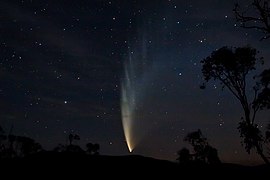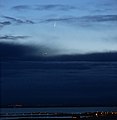
A comet is an icy, small Solar System body that, when passing close to the Sun, warms and begins to release gases, a process that is called outgassing. This produces a visible atmosphere or coma, and sometimes also a tail. These phenomena are due to the effects of solar radiation and the solar wind acting upon the nucleus of the comet. Comet nuclei range from a few hundred meters to tens of kilometers across and are composed of loose collections of ice, dust, and small rocky particles. The coma may be up to 15 times Earth's diameter, while the tail may stretch beyond one astronomical unit. If sufficiently bright, a comet may be seen from Earth without the aid of a telescope and may subtend an arc of 30° across the sky. Comets have been observed and recorded since ancient times by many cultures and religions.

Comet Hale–Bopp is a comet that was perhaps the most widely observed of the 20th century and one of the brightest seen for many decades.
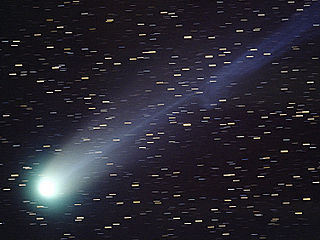
Comet Hyakutake is a comet, discovered on 31 January 1996, that passed very close to Earth in March of that year. It was dubbed The Great Comet of 1996; its passage near the Earth was one of the closest cometary approaches of the previous 200 years. Hyakutake appeared very bright in the night sky and was widely seen around the world. The comet temporarily upstaged the much anticipated Comet Hale–Bopp, which was approaching the inner Solar System at the time.

Comet Machholz, formally designated C/2004 Q2, is a long-period comet discovered by Donald Machholz on August 27, 2004. It reached naked eye brightness in January 2005. Unusual for such a relatively bright comet, its perihelion was farther from the Sun than the Earth's orbit.

The Great January Comet of 1910, formally designated C/1910 A1 and often referred to as the Daylight Comet, was a comet which appeared in January 1910. It was already visible to the naked eye when it was first noticed, and many people independently "discovered" the comet. At its brightest, it outshone the planet Venus, and was possibly the brightest comet of the 20th century.
The Kreutz sungrazers are a family of sungrazing comets, characterized by orbits taking them extremely close to the Sun at perihelion. They are believed to be fragments of one large comet that broke up several centuries ago and are named for German astronomer Heinrich Kreutz, who first demonstrated that they were related. A Kreutz sungrazers's aphelion is about 170 AU from the Sun; these sungrazers make their way from the distant outer Solar System from a patch in the sky in Canis Major, to the inner Solar System, to their perihelion point near the Sun, and then leave the inner Solar System in their return trip to their aphelion.

Comet Pojmański is a non-periodic comet discovered by Grzegorz Pojmański on January 2, 2006 and formally designated C/2006 A1. Pojmański discovered the comet at Warsaw University Astronomic Observatory using the Las Campanas Observatory in Chile as part of the All Sky Automated Survey (ASAS). Kazimieras Cernis at the Institute of Theoretical Physics and Astronomy at Vilnius, Lithuania, located it the same night and before the announcement of Pojmański's discovery, in ultraviolet images taken a few days earlier by the SWAN instrument aboard the SOHO satellite. A pre-discovery picture was later found from December 29, 2005.
Comet C/2006 M4 (SWAN) is a non-periodic comet discovered in late June 2006 by Robert D. Matson of Irvine, California and Michael Mattiazzo of Adelaide, South Australia in publicly available images of the Solar and Heliospheric Observatory (SOHO). These images were captured by the Solar Wind ANisotropies (SWAN) Lyman-alpha all-sky camera on board the SOHO. The comet was officially announced after a ground-based confirmation by Robert McNaught on July 12.
Comet C/2002 V1 (NEAT) is a non-periodic comet that appeared in November 2002. The comet peaked with an apparent magnitude of approximately –0.5, making it the eighth-brightest comet seen since 1935. It was seen by SOHO in February 2003. At perihelion the comet was only 0.099258 astronomical units from the Sun.
C/2007 F1 (LONEOS) is a hyperbolic comet discovered on March 19, 2007 as part as the Lowell Observatory Near Earth Object Search (LONEOS). The comet reached perihelion, or closest approach to the sun on October 28, 2007.

Comet Lulin is a non-periodic comet. It was discovered by Ye Quanzhi and Lin Chi-Sheng from Lulin Observatory. It peaked in brightness and arrived at perigee for observers on Earth on February 24, 2009, at magnitude +5, and at 0.411 AU from Earth. The comet was near conjunction with Saturn on February 23, and outward first headed towards its aphelion, against the present position of background stars, in the direction of Regulus in the constellation of Leo, as noted on February 26 and 27, 2009. It was expected to pass near Comet Cardinal on May 12, 2009. The comet became visible to the naked eye from dark-sky sites around February 7. It figured near the double star Zubenelgenubi on February 6, near Spica on February 15 and 16, near Gamma Virginis on February 19 and near the star cluster M44 on March 5 and 6. It also figured near the planetary nebula NGC 2392 on March 14, and near the double star Wasat around March 17. According to NASA, Comet Lulin's green color comes from a combination of gases that make up its local atmosphere, primarily diatomic carbon, which appears as a green glow when illuminated by sunlight in the vacuum of space. When SWIFT observed comet Lulin on 28 January 2009, the comet was shedding nearly 800 US gallons (3,000 l) of water each second. Comet Lulin was methanol-rich.

A comet tail—and coma—are features visible in comets when they are illuminated by the Sun and may become visible from Earth when a comet passes through the inner Solar System. As a comet approaches the inner Solar System, solar radiation causes the volatile materials within the comet to vaporize and stream out of the nucleus, carrying dust away with them. Separate tails are formed of dust and gases, becoming visible through different phenomena; the dust reflects sunlight directly and the gases glow from ionisation. Most comets are too faint to be visible without the aid of a telescope, but a few each decade become bright enough to be visible to the naked eye.
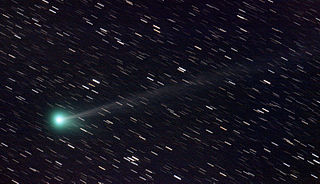
C/2009 R1 (McNaught), one of more than fifty comets known as Comet McNaught, is a non-periodic comet discovered by British-Australian astronomer Robert H. McNaught on September 9, 2009, using the Uppsala Southern Schmidt Telescope at Siding Spring Observatory in New South Wales, Australia. The discovery was confirmed the same day at the Optical Ground Station telescope at Tenerife. After the discovery, earlier images of the comet were found from July 20, August 1, and August 18, 2009. It is believed C/2009 R1 will leave the Solar System permanently.
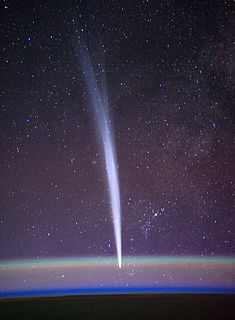
Comet Lovejoy, formally designated C/2011 W3 (Lovejoy), is a long-period comet and Kreutz sungrazer. It was discovered in November 2011 by Australian amateur astronomer Terry Lovejoy. The comet's perihelion took it through the Sun's corona on 16 December 2011, after which it emerged intact, though greatly impacted by the event.

C/2012 F6 (Lemmon) is a long-period comet discovered in Leo on 23 March 2012, by A. R. Gibbs using the 1.5-m reflector at the Mt. Lemmon Survey, located at the summit of Mount Lemmon in the Santa Catalina Mountains north of Tucson, Arizona, USA. Initially, the object was considered to be of asteroidal nature before later observations confirmed its cometary appearance. Comet Lemmon has a highly eccentric orbit, bringing it as close to 0.73 AU from the sun at perihelion and as far as 973 AU from the sun at aphelion. This also leads to the comet's long-period nature with an orbital period of approximately 8,000 years based on epoch 2050. The comet last reached perihelion on 24 March 2013.

C/2014 Q2 (Lovejoy) is a long-period comet discovered on 17 August 2014 by Terry Lovejoy using a 0.2-meter (8 in) Schmidt–Cassegrain telescope. It was discovered at apparent magnitude 15 in the southern constellation of Puppis. It is the fifth comet discovered by Terry Lovejoy. Its blue-green glow is the result of organic molecules and water released by the comet fluorescing under the intense UV and optical light of the Sun as it passes through space.
C/2003 A2 (Gleason) is a hyperbolic comet from the Oort cloud discovered on January 10, 2002 by Arianna E. Gleason of the Lunar and Planetary Laboratory using the Spacewatch II telescope at the Kitt Peak National Observatory. It has a heliocentric semimajor axis of -1641 AU and reached its perihelion of 11.43 AU on November 4, 2003. C/2003 A2 (Gleason) was the first comet discovered with a perihelion beyond 10 AU.

C/2020 F3 (NEOWISE) or Comet NEOWISE is a long period comet with a near-parabolic orbit discovered on March 27, 2020, by astronomers during the NEOWISE mission of the Wide-field Infrared Survey Explorer (WISE) space telescope. At that time, it was an 18th-magnitude object, located 2 AU away from the Sun and 1.7 AU away from Earth.

C/2021 A1 (Leonard) is an inbound long period comet discovered by G. J. Leonard at the Mount Lemmon Observatory on 3 January 2021 (a year before perihelion) when the comet was 5 AU (750 million km) from the Sun. Jupiter's orbit (5 AU from the Sun) is about the distance from the Sun that methanol (CH3OH) and water start sublimation. This is the first comet discovered in 2021 and has a retrograde orbit. On 12 December 2021 the comet will be 0.233 AU (34.9 million km) from Earth and on 18 December 2021 will be 0.028 AU (4.2 million km) from Venus. It will make its closest approach to the Sun on 3 January 2022. It may reach naked eye visibility in December 2021. At an apparent magnitude of 4, it should be a good binocular comet. After perihelion the comet will be ejected from the Solar System. In recent images the comet is showing signs of a tail. Most probably it is a dust tail as gaseous tail doesn't show up in images at that distance. The dust tail is now distinctly visible in images. It is more than half a arc minute long.
C/2010 U3 (Boattini) is the hyperbolic comet with the longest observation arc and took around a million years to complete half an orbit from its furthest distance in the Oort cloud. It was discovered on October 31, 2010 by Andrea Boattini in images taken with the Mount Lemmon Survey's 1.5-m reflector. The perihelion point is outside of the inner solar system.
